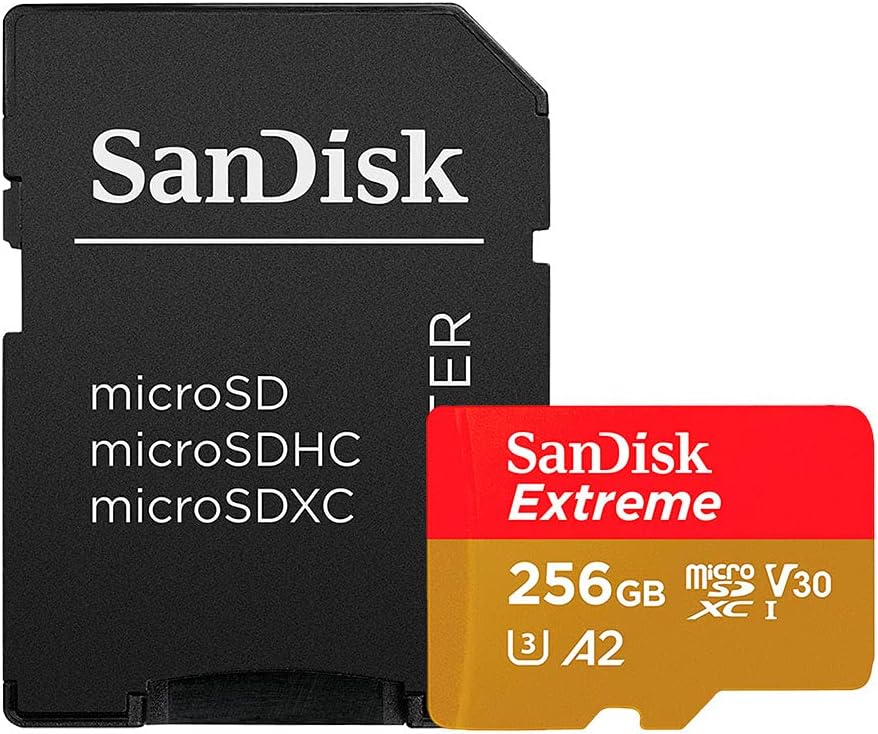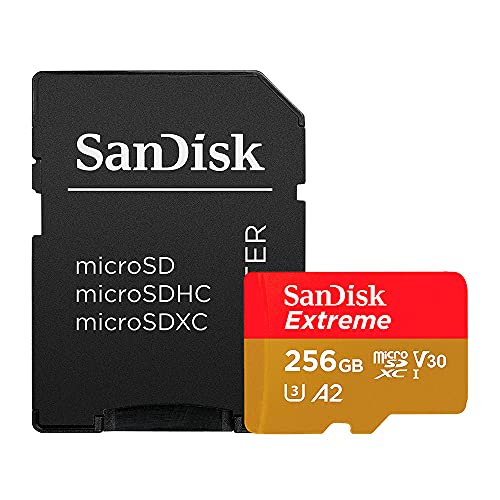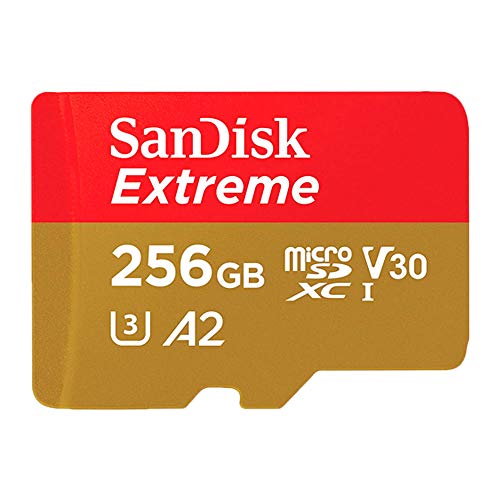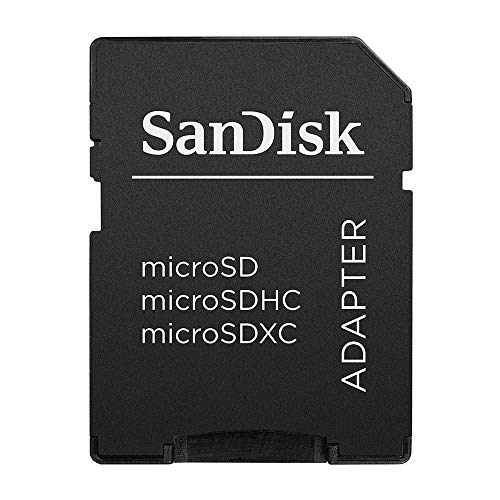
Original price was: €68.00.€12.69Current price is: €12.69.
SanDisk 256GB Extreme microSDXC Card Price comparison
SanDisk 256GB Extreme microSDXC Card Price History
SanDisk 256GB Extreme microSDXC Card Description
SanDisk 256GB Extreme microSDXC Card: A Must-Have for Your Devices
The SanDisk 256GB Extreme microSDXC Card is ideal for anyone needing reliable, high-speed storage for their devices. With its rugged features and impressive performance, this card ensures you never miss a moment, whether you’re capturing high-resolution photos, filming 4K videos, or expanding your storage capacity. In this comprehensive guide, we’ll explore the card’s key features, benefits, and how it stands up against competitors. Get ready to discover why this microSD card is a favorite among photographers, videographers, and tech enthusiasts alike.
Key Features and Benefits
- Massive 256GB Storage Capacity: Perfect for storing large files, apps, or media without worrying about running out of space.
- High Read Speed: With a read speed of up to 160MB/s, the SanDisk Extreme microSD card ensures rapid file transfers and smooth playback.
- Fast Write Speed: Its write speed of 90 MB/s allows you to capture stunning photos and videos without lag, making it suitable for burst shooting.
- Rugged Design: Features like being waterproof, x-ray proof, temperature proof, and shockproof make this card durable and reliable in extreme conditions.
- Compatibility: Designed for use with various devices, including cameras and smartphones, ensuring versatility for all your storage needs.
Price Comparison Across Suppliers
You can find the SanDisk 256GB Extreme microSDXC Card at various retailers, including Amazon, Best Buy, and Walmart. Prices can fluctuate based on promotions and availability, but generally, you can expect to pay between $30 and $50. Use our detailed price comparison feature to track pricing trends and secure the best deal.
6-Month Price History Trends
The 6-month price history chart of the SanDisk Extreme microSD card shows some notable trends. Over the past half year, prices have consistently been competitive, with occasional discounts during holiday sales. This analysis indicates that waiting for the right time can lead to significant savings. The card tends to be cheaper during major sales events, making it wise to keep an eye on pricing options.
Customer Reviews: What Users Are Saying
Customer feedback on the SanDisk 256GB Extreme microSDXC Card is overwhelmingly positive. Users frequently highlight its speed and reliability, particularly for 4K video recording and burst photography. Many appreciate its rugged features, noting that it withstands harsh conditions without issue.
However, some customers have pointed out that the card can be challenging to access initially, especially if using with devices that require a specific adapter. Additionally, a few users have reported occasional compatibility issues with older devices. Overall, the benefits far outweigh the drawbacks, making this card a top choice in the market.
Explore Unboxing and Review Videos
For those who enjoy visual guides, several YouTube reviewers have created unboxing videos and in-depth reviews of the SanDisk 256GB Extreme microSDXC Card. These videos demonstrate its speed and durability in real-world scenarios, allowing potential buyers to see the performance firsthand. Watching these reviews can help you understand the product’s value and how it fits into your storage needs.
Why Choose the SanDisk 256GB Extreme microSDXC Card?
If you’re seeking a robust, high-speed solution for your digital storage needs, the SanDisk 256GB Extreme microSDXC Card should be at the top of your list. It not only offers exceptional performance but also provides peace of mind with its rugged build and extensive compatibility. Whether for personal use or professional projects, this card is designed to handle the demands of modern photography and videography.
To sum up, the SanDisk 256GB Extreme microSDXC Card is a reliable and versatile option that meets the needs of various users. From photographers and videographers to tech enthusiasts, its impressive specifications and features make it a standout choice. Don’t miss out on the opportunity to elevate your storage game.
Ready to enhance your device storage? Compare prices now!
SanDisk 256GB Extreme microSDXC Card Specification
Specification: SanDisk 256GB Extreme microSDXC Card
|
SanDisk 256GB Extreme microSDXC Card Reviews (13)
13 reviews for SanDisk 256GB Extreme microSDXC Card
Only logged in customers who have purchased this product may leave a review.











oldgammer –
Worked well in a gopro hero black 12 at 4k 60fps. Took it diving at 100ft and no issues
ANTONIO M. –
Performance:
The performance of this card is impressive, with read speeds of up to 160MB/s and write speeds of up to 90MB/s. While it is not the fastest on the market, it is more than sufficient for most tasks, including 4K video recording and high-resolution photography. The speed ratings of U3, C10, V30, and UHS-I make it a reliable choice for handling large files and intensive data tasks.
Usability:
One of the standout features of the SanDisk Extreme microSDXC card is its A2 rating, which signifies excellent app performance. This makes it an ideal choice for expanding storage on smartphones and tablets, ensuring apps run smoothly without significant lag.
Quality and Reliability:
SanDisk has a well-established reputation for producing high-quality memory products, and this card is no exception. It feels robust and durable, giving confidence that my data is secure. It’s also designed to be resistant to water, temperature extremes, shock, and X-rays, which adds an extra layer of protection for my data.
Cost:
While this card is on the pricier side, the cost is justified by its performance and reliability. For those who need a dependable and fast microSDXC card for high-stakes tasks like 4K video recording or extensive app usage, the extra expense is worth it.
Data Transfer Speeds:
Though the card boasts impressive speeds, I found that it is not the absolute fastest when it comes to data transfer. However, the speeds it offers are still very good and adequate for most users. Transferring large files and video footage is smooth, though if you require the fastest possible speeds, you might want to look at other high-end options.
Conclusion:
The SanDisk 128GB Extreme microSDXC card is a high-quality, reliable, and fast storage solution. It is particularly suited for users who need robust performance for 4K video, high-resolution photography, and app storage. While it is not the fastest card available and comes with a higher price tag, its overall performance and durability make it a worthwhile investment.
Paulo –
I picked up the SanDisk Extreme microSDXC memory card a few months ago, motivated by its excellent reputation for reliability and performance. My expectations were high: a card capable of handling large files quickly, ideal for cameras, drones or smartphones.
Using this card was a real pleasure. Its high transfer speed allowed me to move and access my files quickly, which is crucial when you don’t want to waste a moment. However, I noted that in extreme conditions its performance may fluctuate slightly.
In terms of quality, the SanDisk Extreme does not disappoint. It resists shock, water and extreme temperatures, making it a perfect choice for adventurers. Its performance is up to par, with competitive read and write speeds.
Highlights: high speed, durable, large storage capacity.
Cons: Slightly inconsistent performance in extreme conditions, somewhat high price.
Compared to other microSD cards on the market, the SanDisk Extreme stands out for its speed and reliability. However, for those looking for a more economical option, brands like Kingston or Samsung offer interesting alternatives.
To maintain its performance, I recommend formatting the card regularly and storing it in a dry place at room temperature.
Technical details
– Capacity: up to 1 TB.
– Reading speed: up to 160 MB/s.
– Resistance to the elements: waterproof, shock and temperature resistant.
For optimal performance, use this card with devices that support UHS-I. It is ideal for recording and playing 4K videos.
The SanDisk Extreme microSDXC memory card is an excellent choice for those looking for speed and reliability. It represents a safe investment for enthusiasts of photography, videography or simply to increase the storage of their smartphone.
shyshen –
Muito bom e rápido
A. Cruz –
Very easy to use and I love that it hold so much information. Well worth the money.
baldylocks –
There is not much you can say in a review about this product. It is a storage tool, like most, it is easy to transfer items onto it. I mainly use for my music; I load the music and stick this card in my MP-3 player. I currently have over 5000 songs on it, and it has barely used any space. Like all cards, they do wear out with consistent load/unload cycles like I put mine through, but they are cheap to buy and hold a ton of info. The only problem I have had with this card, it likes to hide from me. Keep a little cup or bowl nearby so when you take it out of your player, phone or other devices so it doesn’t run away.
A. Cruz –
In short this is a great card and it’s speed falls close to it’s advertised speeds.
ADVERTISED ACTUAL
READ: 160 MB/s 149 MB/s (93.13% of advertised speed)
WRITE: 90 MB/s 109 MB/s (121.11% of advertised speed)
The results above are from the SanDisk Extreme 128 GB card, SDSQXA1-128G-GN6MA bought in Q1 of 2021.
Unfortunately, there are MANY fake SanDisk cards on the market everywhere and they can be very problematic if bought and used. I highly suggest you test ANY sd card that you buy. In general, I always want to get at least 90% of claimed speeds. Different hardware or software optimizations can make it to where you may not get speeds as high as claimed, but if you are close to them, close is good enough.
Only read on if you are researching SD cards and verification or are just a nerdy person like myself.
When looking up SD cards it’s important to keep a few things in mind:
* Investigate the claims for speed if it is important to you. The card may say xxx MB/s write speed* That asterisk may reference that the speed is only guaranteed when using a certain software. Since you might be like me and installing the card into a phone, that phone will most likely not use that software so the speeds will be lower. For a more real-world speed, look at reviews who have verified the speeds either in the device that you plan to use it in, or by other software to benchmark it.
* Always test the speed of the card once you get it (The speeds above come from a program known as H2testw)
* Always test the storage capacity of the card.
* I highly recommend that you test your card using H2testw. It tests the two most important things about your storage: actual speeds, and actual storage. Fake or faulty cards cannot hit their advertised speeds. Fake cards often are edited to report a false storage to your computer. Say you buy a 128GB card and you read the size in Windows, 119 GB. Seems close enough right? Well this is not a guarantee of the real storage capacity. The card could be a 4 GB card that is written to report itself as 119 GB. For the first 4 GB of space or so there will be no issues with the card, aside from likely slow speeds, since fake cards often use slower, cheaper memory. After writing these 4 gigabytes however, you will inevitably have data corruption. The original 4 GB stored on the card will start to be overwritten by the next data to come. This can result in a total loss of date. This is the big danger with fake cards. It’s one thing to have a slow card, but another thing entirely to lose your data. You could lose valuable data and there are times when this data cannot be recovered.
* Know that your storage space will always be less than advertised. In my case, my 128 GB card has an actual storage space of 119 GB. This is in mainly due to the fact that the advertised capacity is often the unformatted, “RAW” size in decimal (base 10) storage. However, your computer reads storage in binary (base 2) storage. In this case, if we take 128 GB of decimal gigabytes and convert it to binary gigabytes, we get 119.21 binary gigabytes. When your card is formatted, it is formatted using base 2 since your computer understands binary. Decimal is essentially only used for advertising as far as us typical consumers are concerned. H2testw will test the true capacity by filling the entire card with however much information it can put into it, then reading it back and verifying that the information stored is correct. A fake card may be 4GB and allow 119GB to be written to it, but when the information is checked, there will be discontinuities in the data and the fake card will be exposed as such.
Good luck finding a card that works for you.
Fyhy –
Basically it does what it’s supposed to do. I got this as a spare for my drone, and it works great. After years of using it’s still working flawlessly.
I know you can probably catch this listing cheaper on one of the sale days that happens every so often. But overall if you live in BFE like I do, and have to go extremely out of your way to a Walmart at the best scenario, for the possibility they don’t even have what you need with select specs you need, could be out of stock, or just don’t carry what you are looking for. It’s just simpler to shop online, and order it and forget it, at least until it arrives.
Overall I can’t complain one bit with this purchase! Got exactly what I was looking for, and even needed, price was fine, quality was good, specs was solid, everything was good! So yeah solid buy in all honesty. Fully recommend.
Janna –
I haven’t had good luck with Sandisk micro SD cards. I haven’t had any failures but these are my two issues:
1. On large file transfers – more than 1gb – Sandisk tends to overheat and lose transfer speed. This is worse writing TO the card than reading from it. Transfer speeds are stil ok, but nothing like the speeds I get from my USB 3.1 port with a thumbdrive. Several years ago the problem was so severe my files got corrupted even when the on-board thermal protection was throttling my transfer speeds down to 5-10 megabytes per second. In the past two years data loss has ceased to be a problem, and the speed hit on large file transfers is much less severe, although Samsung continues to run faster, in real life big file transfers, than San Disk, at least for me.
2. I don’t think Sandisk really meets the specs required for “extendable” or “unified” storage on Android, that or it throttles so early the perfomance on small, constant file reads and writes suffers more than it should. I almost always get an error message with their A1 cards on budget (Qualcom 42x chipset) phones complaining the storage is slow and hence not optimal as unified storage. I haven’t gotten this error message with my two Fire HD 10 9th gen tablets on this latest A2 iteration, however, which may be a function of the chipsets and memory controller used in these tablets or maybe the upgrade from A1 to A2 makes a difference.
I purchased two Fire HD 10’s, 2020 editions/9th gen (the second one purchased on Prime Day for just $80, which is insanely cheap) and two of these A2 class Sandisk 128gb micro SD cards.
A2 means the memory controller built into the micro SD card should be fast enough to run apps (not gaming apps!) from the card, not just read storage data.
The real challenge is for app-rated (A1 or A2) card to handle data reads and writes for multiple apps at the same time. “Same time” is critical – it’s not reading a single big file that creates problems for micro SD cards, it’s reading small files at nearly the same time to handle the needs of multiple apps running at the same time. The way to avoid any performance issues is to NOT allow the operating system to “move” apps from true internal storage to the SD card. Only data.
The first 128gb drive installed perfectly easily in my first Fire as “portable” or “removable” storage but that is not surprising. The second card was installed as “internal storage” in the second Fire glitched several times, crashing once, and not recognized by the tablet as storage at all. I don’t know what I finally did to get past the glitches. but as far as I can tell what finally worked was first formatting it as “portable” storage first, rthen ebooting, then re-formatting it as “internal” storage.
I was “offered” a chance to move some apps onto the SD card after formatting as internal storage. DO NOT do this – the 32gb of internal, faster storage is a much better place to run apps from, not the SD card even though it is A2 “app-friendly” classified. All CONTENT will automatically go to the SD card in the future, such as downloaded Netflix and Prime Videos.
Pay attention to the following issues which might develop:
1. Simultaneously downloading videos or other content AND watching a previously stored video. This can tax the memory controller in the SD card since essentially the device is attempting to read your video and write your downloading episodes at the same time (subject to buffering). It shouldn’t be a problem,but it might. I usually download content when I’m not using the tablet.
2. Moving lots of content from external storage – like a thumb drive – to internal storage. The process is ALWAYS a lot faster going from USB 3 thumbdrives to internal factory storage, and slower when writing to the SD card.
In my review title I mentioned I prefer Samsung. Without doubt they make more dependable SD cards that more consistently “hit” their specs and don’t throttle down as much on large file transfers. However, Sandisk pretty much “owns” the A1 and A2 “app friendly” micro SD space, and they frequently go on sale. Since they no longer “corrupt” large file transfers (I’m talking about moving a 30gb music collection to an SD card in a computer, not just a couple of gb), I no longer avoid Sandisk like the plague. Still, as they say, once burned twice wary.
I’m hunting for reviews from Raspberry Pi users. Running an actual operating system from a micro SD card is equally hard, or harder, than running Android apps. So far, the micro SD cards recommend for those Raspberry Pi systems are NOT A1 or A2 class or even necessarily “faster” micro SD cards – apparently speed on larger files doesn’t necessarily correlate to the speed required for smaller, constant file transfers that an operating system needs.
It’s good to see micro SD card prices become so low and commodity-like. I can remember when cards were a dollar a gigabyte, or much more. For under $20 I’m more than willing to give this Sandisk A2 128gb micro SD card a workout in my Fire HD 10 9th gen.
I’m also a little surprised to see all the new brand names. I’m used more to Samsung and Sandisk at the top, with Kensington, Patriot, etc. as the next tier. My guess is Chinese subcontractor factories feel less bound to have a long-standing brand name and are just going direct to market. Time will tell how this works out for consumers.
Pascal Grenier –
Muito bom ,só demorou a entrega.
mlknez –
REALMENTE SI FUNCIONA PARA NINTENDO QUE ERA LO QUE ME INTERESABA
MLu –
The read and write speed of this microSD was needed to a 4-channel dash cam to ensure proper operation. There are quick reads and file transfers. No issues thus far, recommend.
MDuck –
Decently priced